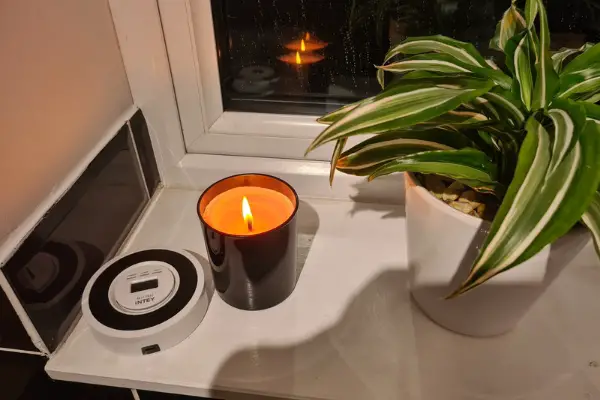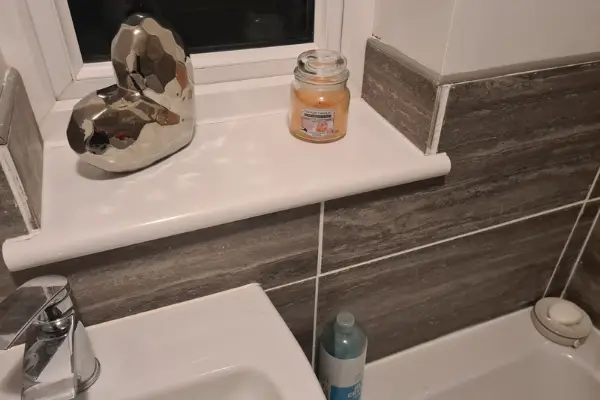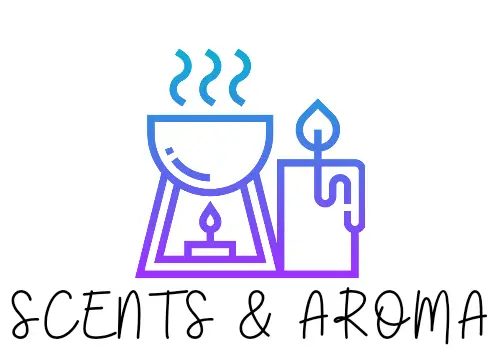When candles were first invented, they were used for light and warmth. Nowadays, we’ve moved on from candles being a necessity to adding a little extra to our space. Candles can make a room feel more homely and more relaxing. They can also release a scent into the air to avoid unpleasant odours or add a delicate fragrance to a room.
While people are often clued up on fire safety when it comes to lighting candles, one question that people often wonder is, do candles produce carbon monoxide? The short answer is that, yes, candles do produce carbon monoxide. However, the amount that a candle produces is so small that the risk of poisoning is almost impossible. As long as you don’t light dozens of candles in an air tight room you will be fine.
So let’s look into candles and carbon monoxide more closely.

What is carbon monoxide?
Carbon monoxide (CO) is a gas. The gas’s colourless and odourless properties are one thing that makes it more risky – if we can’t see it or smell it, we don’t know it’s there.
We’re more familiar with carbon dioxide (CO2), but the gases are very different. Carbon monoxide consists of one atom of oxygen and one atom of carbon, while carbon dioxide consists of two atoms of oxygen and one atom of carbon.
The most common source of CO is thermal combustion. Humans even produce carbon monoxide in small quantities! It’s believed that carbon monoxide plays a role in climate change.
What is carbon monoxide poisoning?
When people have exposure to carbon monoxide, the carbon monoxide molecules gradually displace oxygen and cause poisoning. But, because we can’t see it, we don’t know that we are being poisoned, and there is no way to know until you become seriously ill.
The symptoms of carbon monoxide poisoning often appear similar to the flu, which is why many people ignore that they’re feeling unwell.
There are many sources of carbon monoxide in the home, including gas stoves, grills, power tools, tobacco smoke, wood stoves, water heaters, clothes dryers, and fireplaces.
Typically, the concentration of CO in a room should be the same as those outside.
How to tell the difference between carbon monoxide poisoning and flu
When people are feeling flu-like symptoms due to carbon monoxide poisoning, they will often feel better when they are away from home – i.e. when they go to school, work, or visit other people.
If everyone is sick at exactly the same time, this might also be a reason to suspect. What’s more, indoor pets would act sick too. Also, unlike with the flu, you wouldn’t experience swollen lymph nodes or have a fever or body aches. But, on the other hand, you might also notice symptoms worsening whenever there is fuel-burning equipment running.
The first signs of carbon monoxide exposure are breathlessness when engaging in moderate exercise and a mild headache. If exposure continues, you might have more severe headaches, fatigue, nausea, and dizziness. Eventually, these symptoms progress to confusion, impaired judgement, irritability, and loss of consciousness.
Can candles cause carbon monoxide poisoning?
Although candles do produce carbon monoxide, the amount released is not enough to cause you harm. For example, if you were in a small room, like a bathroom, and had lots of candles lit at once, you would be exposed to a higher level of carbon monoxide. However, it is unlikely that you would have any problems as a result.

With candles, your biggest danger is the naked flame and something catching fire in your home. The risk of carbon monoxide poisoning in comparison is negligible.
It doesn’t matter whether the candle is scented, paraffin, soy or beeswax, it will still produce the same amount of carbon dioxide. However, paraffin candles do give off other harmful substances, including toxic carcinogens.
Is it safe to burn a candle in a closed room?
If you burn a candle in a larger room, you won’t have to worry at all about carbon monoxide, which means you can keep burning your candles worry-free. However, if you’re burning a candle in a small room that doesn’t have ventilation, you may wish to be more cautious.
Single candles in a closed room won’t let off much carbon monoxide, but multiple candles will. If you choose to use more than one candle, you should keep a door ajar or open a window for ventilation.
It’s also important to never sleep with candles burning in your room. Not only is it dangerous in terms of carbon monoxide build-up, but it is a big fire risk too.
With most candles, it is only recommended to burn them for three or four hours, so if you burn one overnight, the candle will deteriorate, and the container may even become damaged.
To avoid all dangers associated with burning candles, you should ensure you extinguish them before going to sleep.
I actually wrote an article about trying to heat a room with candles that would be the perfect example of how you could get carbon monoxide poisoning from candles
Be sure to be safe with a carbon monoxide detector
If you burn many candles and feel unsure about your carbon monoxide risk, you can always ease your worries by getting a carbon monoxide detector. These are available from most hardware stores and online.
The carbon monoxide detector should be placed high up in your room. If you live on more than one floor, you can get more than one detector.
Carbon Monoxide Detectors have a sensor that will alert you if the level of carbon monoxide in your room becomes harmful. It will take time before levels build-up, so as soon as the detector alerts you, you will be able to take action to resolve the issue. This might mean opening doors and windows and extinguishing candles and open fires.
Final thoughts – do candles produce carbon monoxide?
While we’ve seen that candles do produce carbon monoxide, burning a single candle in a large room is not going to cause any harm. After all, even humans produce a small amount of carbon monoxide too!
Carbon monoxide is dangerous in large quantities, but it’s not likely to cause a problem when people are burning candles.
The problem with candles and carbon monoxide is if you burn lots of candles in a small and unventilated place, like a bathroom. They’re also dangerous if you leave them burning when you go to bed, not just for the carbon monoxide build-up, mainly for the unattended naked flames and the problems that might occur due to this.
If you are worried about carbon monoxide and candles, you could invest in a carbon monoxide detector for peace of mind. You should also be aware of the signs and symptoms, including flu-like symptoms (without fever), headaches, confusion, and breathlessness.
Ultimately, your biggest danger from burning a candle is the flame itself. For example, if you’re burning a paraffin candle, the release of carcinogens and toxins on burning is more significant than the minimal amount a candle will emit.
- Can You Put Perfume In A Humidifier? (Read First) - September 17, 2022
- Can You Put Essential Oil In A Steam Mop? (Safety Advice) - September 17, 2022
- How To Make Lavender Oil At Home ( Candles And Diffusers) - September 9, 2022
